French Polynesia, an overseas collectivity of France, is a mesmerizing paradise comprising over 100 islands scattered across the South Pacific.
This enchanting region is renowned for its astonishingly clear, blue waters, vibrant marine life, and iconic overwater bungalows that offer an unrivaled experience of luxury and tranquility.
Each island in French Polynesia presents a unique blend of natural beauty and cultural richness, making it a dream destination for travelers seeking both relaxation and adventure.
From the lush mountainous landscapes to the serene lagoons, these islands embody a serene escape from the everyday, offering visitors a glimpse into a world of idyllic splendor and unparalleled serenity.
Best Islands in French Polynesia
1. Bora Bora
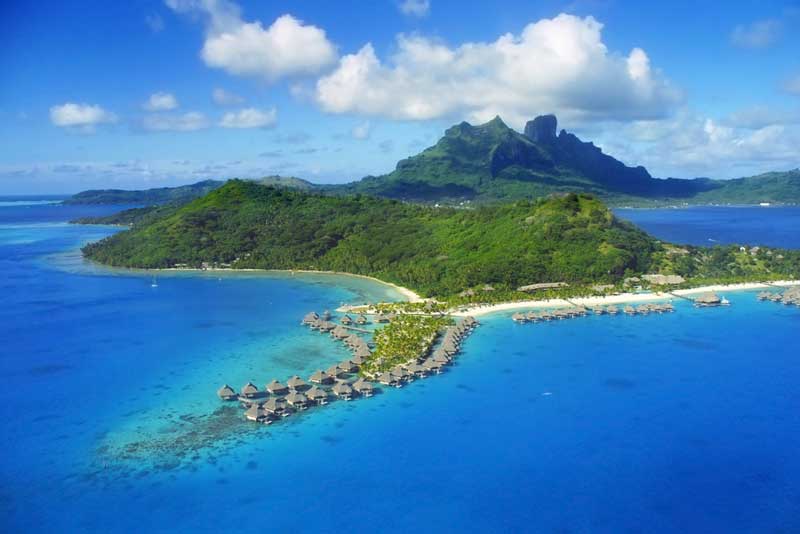
Bora Bora
Bora Bora, often referred to as the ‘Pearl of the Pacific’, is a small South Pacific island northwest of Tahiti in French Polynesia. Renowned for its stunning turquoise lagoon, protected by a coral reef, it’s a popular luxury resort destination.
The island’s interior is dominated by the remnants of an extinct volcano, Mount Otemanu and Mount Pahia, offering hiking trails and panoramic views. Bora Bora’s overwater bungalows are iconic, providing exclusive and serene accommodation experiences, with direct access to the lagoon.
The island’s waters are inhabited by diverse marine life, making it a perfect spot for snorkeling and scuba diving. The blend of its natural beauty, luxurious resorts, and the warm hospitality of its people makes Bora Bora a quintessential tropical getaway.
2. Moorea
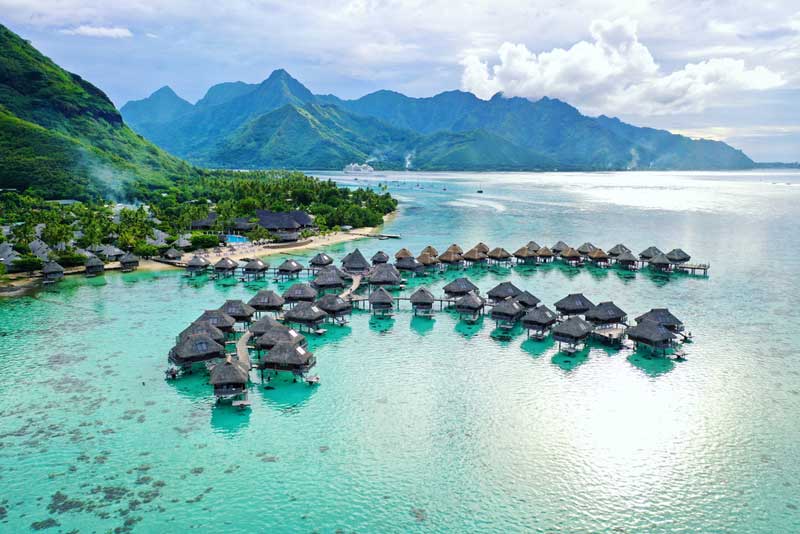
Moorea
Moorea, shaped intriguingly like a heart, is just a short ferry ride away from Tahiti. It’s known for its jagged volcanic mountains and sandy beaches. One of the island’s most striking features is the two large bays on its north shore, Cook’s Bay and Opunohu Bay, which enhance its stunning landscape.
Moorea is less commercialized than Bora Bora, offering a more authentic Polynesian experience. Its crystal-clear waters are ideal for water activities like snorkeling, diving, and kayaking.
The island also offers lush hiking trails leading to viewpoints like Belvedere Lookout, providing breathtaking views of the island’s peaks and Tahiti in the distance. Overwater bungalows in Moorea offer a blend of luxury and immersion in nature, making it a perfect destination for those seeking tranquility and adventure.
3. Tahiti
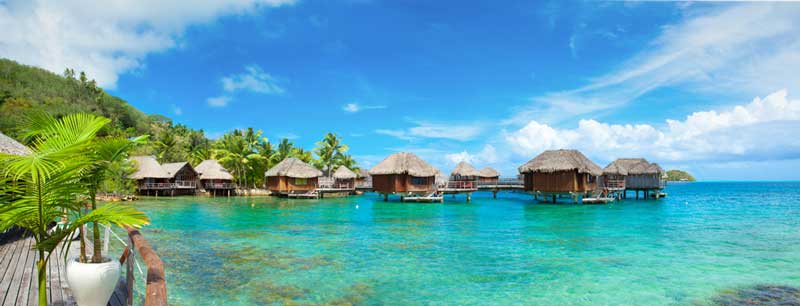
Tahiti
Tahiti, the largest island in French Polynesia, is known as the gateway to the archipelago. Unlike the typical flat, coral-atoll stereotype, Tahiti boasts rugged mountain peaks, lush rainforests, and cascading waterfalls.
Papeete, the capital city, offers a mix of French and Polynesian culture, with bustling markets, sophisticated dining, and vibrant nightlife. Tahiti’s black sand beaches, a result of its volcanic nature, provide a unique seaside experience.
While it may not be as famous for overwater bungalows as Bora Bora, Tahiti offers a range of luxury beachfront resorts with stunning lagoon views. The island is also renowned for its surf spots like Teahupo’o, offering some of the world’s most challenging waves.
Tahiti serves as an excellent starting point for exploring the other islands of French Polynesia and offers a deeper dive into the region’s cultural heritage.
4. Rangiroa
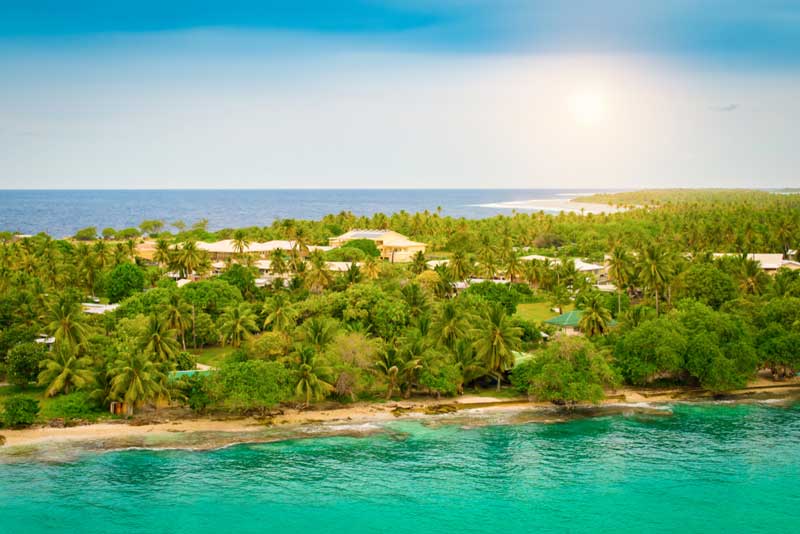
Rangiroa
Rangiroa, located in the Tuamotu Archipelago, is the largest atoll in French Polynesia and the second-largest in the world. This secluded coral atoll is characterized by its flattened islets and skinny sandbars that encircle the vast blue lagoon, offering a unique opportunity to enjoy endless horizons.
The lagoon’s immense size, comparable to the entire island of Tahiti, along with its rich marine life, has made Rangiroa a renowned spot for diving and snorkeling. The atoll is home to the Avatoru Pass and Tiputa Pass, both famous for drift diving and snorkeling, attracting a variety of marine life, including dolphins.
Rangiroa’s lack of permanent fresh water sources poses challenges for the inhabitants, who rely on rainwater collection. The atoll’s ecology and sustainability are delicate, needing careful resource management. Despite these challenges, the island’s culture is vibrant.
The Farerei Haga festival, held every September, showcases traditional dances and local customs. Visitors can enjoy a range of accommodations from luxury hotels to authentic Tahitian Guesthouses, offering insights into the local way of life.
5. Huahine
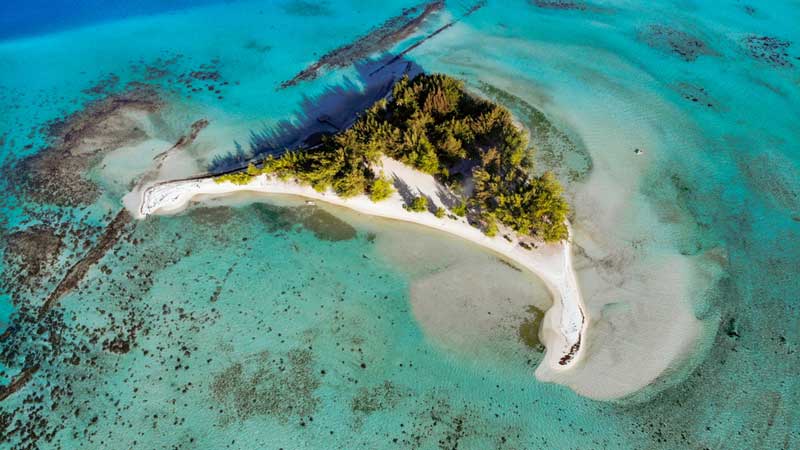
Huahine
Huahine, often dubbed “the authentic island,” is a serene paradise in French Polynesia, less frequented by tourists compared to its neighbors like Bora Bora and Moorea. This island stands out for its lush vegetation, unspoiled landscapes, and a rich cultural heritage that remains deeply embedded in the local lifestyle.
The island’s beaches, particularly around the villages of Fare and Parea, are known for their stunning beauty, offering crystalline waters and a kaleidoscope of blue hues set against green mountains and cliffs.
Visitors to Huahine are greeted with a turquoise lagoon abundant in marine life, including tropical fish, black tip sharks, and turtles. This natural setting is perfect for relaxation and various water activities such as snorkeling and kayaking.
Huahine also boasts a remarkable archaeological heritage with numerous marae (ancient Polynesian sacred places). The Maeva marae near Lake Fauna Nui is particularly impressive, providing insights into the spiritual life of the ancient Polynesians.
6. Taha’a
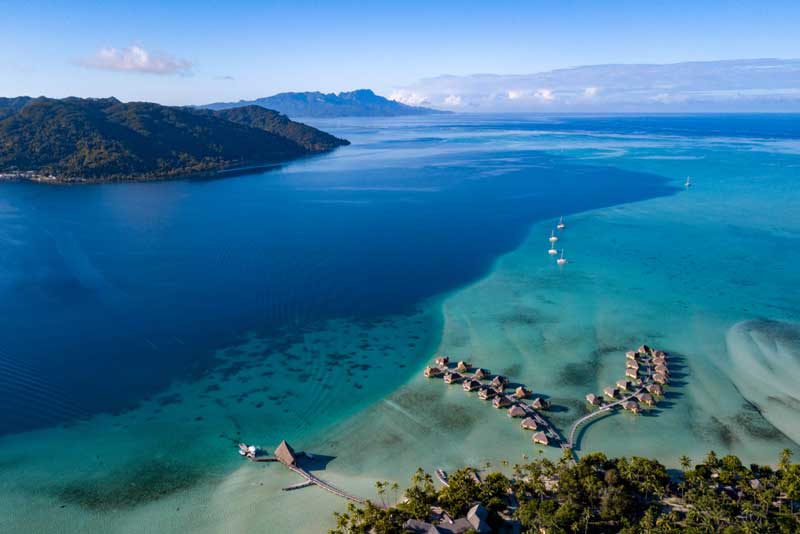
Taha’a
Taha’a, often referred to as the “Vanilla Island,” is a unique destination in French Polynesia, celebrated for its production of high-quality vanilla, which accounts for about 80% of all Polynesian vanilla production.
The island is enveloped by the sweet aroma of vanilla, contributing to its distinctive, enchanting atmosphere. Taha’a shares a lagoon with its sister island Raiatea, and is accessible only by sea from Raiatea, preserving its natural landscapes and tranquil pace of life.
The island’s lush vegetation provides a habitat for various species, including crabs, barracudas, gray sharks, Napoleon wrasses, dolphins, oysters, and corals.
The island’s economy is based on fishing, tourism, vanilla production, and black pearl harvesting. The island’s culture includes unique traditions such as “rock fishing,” an ancient method used by local fishermen.
For visitors, Taha’a offers a plethora of activities, including exploring the island’s hiking trails, kayaking through the lagoon, snorkeling at the Coral Garden, and visiting vanilla plantations.
The island’s remote and intimate setting makes it an ideal destination for those seeking a serene and authentic Polynesian experience, away from the usual tourist circuits. It’s a perfect spot for honeymooners or anyone looking to indulge in romantic seclusion.
7. Raiatea
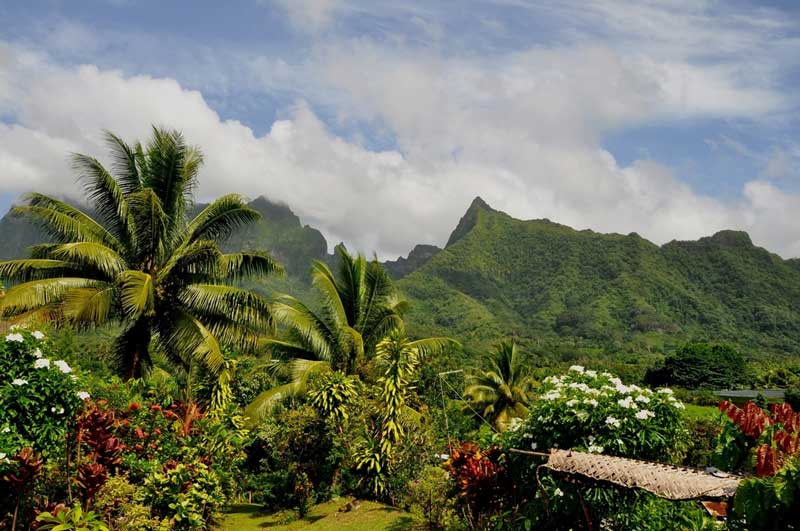
Raiatea
Raiatea, known as the ‘Sacred Island,’ is a significant cultural and historical center in French Polynesia. It’s the second largest of the Society Islands and is often seen as the cradle of Polynesian culture. This island was once called Havai’i and holds a deep connection with Polynesian navigators who set out to discover the South Pacific islands.
Raiatea is home to the ancient and UNESCO-listed marae Taputapuatea, a thousand-year-old site of great spiritual and historical importance, not just to the island but also to Maoris and Hawaiians.
The island’s rugged landscape, dominated by Mount Tefatoaiti, plunges into a beautiful lagoon it shares with Tahaa, making it a haven for nautical activities. Raiatea doesn’t have its own beaches; however, the surrounding motus offer beautiful sandy shores.
The island’s unique vegetation includes the tiare apetahi, a rare flower found only on Mount Temehani. Raiatea’s natural beauty extends to its only navigable river in Polynesia, the Faaroa River, offering unique kayaking and exploration experiences.
Raiatea is less touristic, offering an authentic experience where one can delve into the heart of Polynesian culture and history.
8. Maupiti
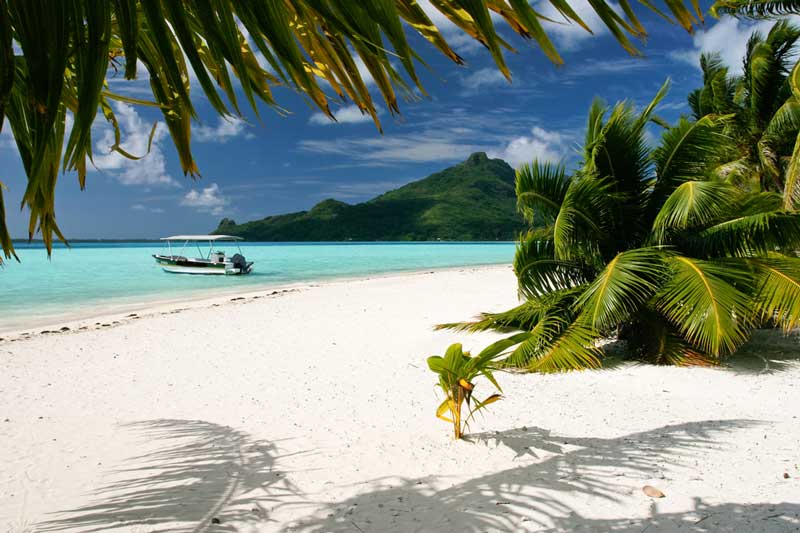
Maupiti
Maupiti, often described as “the Bora Bora of the sixties,” is a small, preserved gem in French Polynesia, radiating authentic Polynesian charm. Just 40 km from Bora Bora, it’s considered a tranquil retreat from the more touristic islands.
The island is renowned for its stunning lagoon with diverse shades of blue and turquoise, encircled by numerous motus with pristine white sandy beaches. It’s a sanctuary for marine life, making it a fantastic spot for snorkeling and diving, especially known for manta ray encounters.
The island itself is rich in hiking trails, offering breathtaking scenic viewpoints, particularly from Mount Teurafaatiu. Maupiti’s culture and history are also captivating, with trails leading to ancient marae, showcasing Polynesia’s rich past.
The local population is known for their warm hospitality, providing a genuine experience of traditional Polynesian life. Accommodations here are primarily traditional guesthouses, reflecting the island’s commitment to preserving its natural beauty and authentic way of life.
9. Fakarava
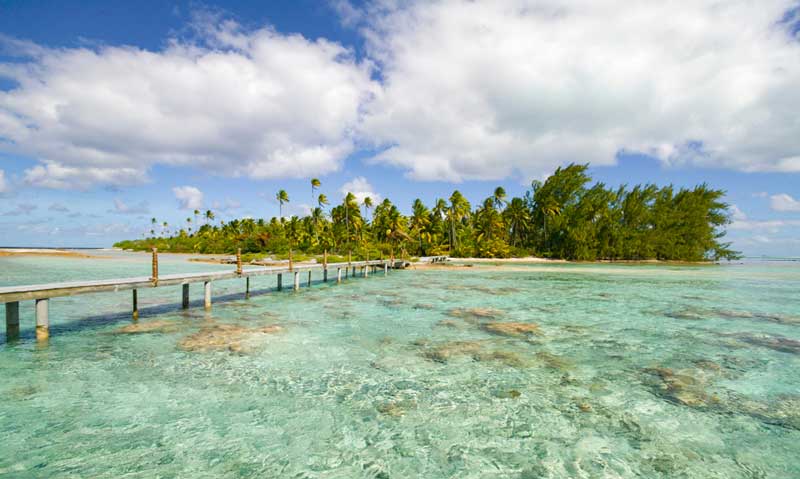
Fakarava
Fakarava, an atoll in the Tuamotu Archipelago, is a UNESCO Biosphere Reserve known for its rich marine life and stunning underwater scenery, including an incredible ‘wall of sharks’. This idyllic atoll, with its large lagoon, is a top destination for diving enthusiasts.
The waters around Fakarava are inhabited by an abundance of marine species like gray sharks, manta rays, dolphins, sea turtles, and tropical fish. The northern passage of Garuae, the largest in French Polynesia, and the southern pass of Tumakohua are especially popular dive spots.
The main village of Rotoava offers insights into the local culture and traditions. Visitors can explore crafts, attend local festivals, and learn about pearl farming, an important local industry. The beaches of Fakarava, known for their soft white and pink sand, are perfect for relaxation.
The atoll also provides opportunities for biking, quad ATV tours, and exploring the reef platform. Despite its remote location and limited accommodation options, Fakarava offers an intimate experience with nature, making it an ideal destination for those seeking adventure and tranquility.
10. Manihi
Manihi, nestled in the Tuamotu Archipelago of French Polynesia, is an atoll renowned for its unspoiled beauty and rich marine life. This tropical paradise, with its crystal clear lagoon, is a haven for divers, offering an underwater world filled with tropical fish and superb coral reefs.
The atoll is also known as the birthplace of pearl farming in French Polynesia, making it a key destination for those interested in the cultivation of these precious jewels.
The main village of Manihi, Turipaoa, provides a window into the daily life on this remote motu. Visitors can engage with locals, shop for crafts, and enjoy evenings filled with traditional dancing and music.
Diving is a major attraction in Manihi. The atoll’s waters are renowned for their extraordinary diversity of sea life, including manta rays. Additionally, visitors can experience fishing in the lagoon’s crystal clear waters, which is ideal for catching species like tuna and barracuda.
With its blend of natural beauty, cultural richness, and unique economic activities, Manihi offers a tranquil and authentic Polynesian experience, making it a must-visit destination for travelers seeking both adventure and serenity.
Final Thoughts
The islands of French Polynesia, each with their unique allure, offer a kaleidoscope of experiences ranging from the tranquility of unspoiled nature to the richness of Polynesian culture and history.
Their pristine beaches, lush landscapes, and vibrant marine life present a paradise for both adventurers and those seeking relaxation.
Known for their significant contributions to pearl farming and their sustainable tourism practices, these islands embody a harmonious blend of natural beauty and cultural heritage. They stand as jewels in the South Pacific, inviting travelers to immerse themselves in a world of serenity, beauty, and cultural depth.
